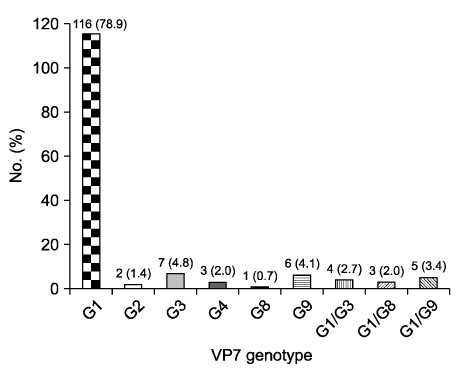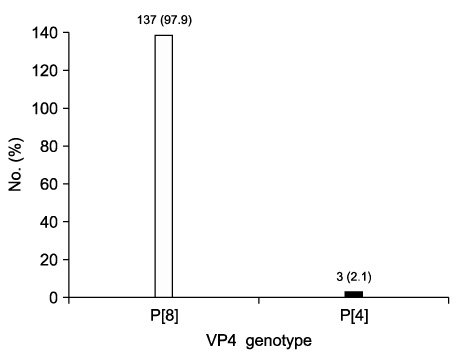Korean J Pediatr Gastroenterol Nutr.
2011 Jun;14(2):148-154. 10.5223/kjpgn.2011.14.2.148.
Distribution of Disease Severity and Group A Rotavirus Genotypes (VP7 & VP4) in Children with Acute Rotavirus Gastroenteritis
- Affiliations
-
- 1Department of Pediatrics, Jeju National University School of Medicine, Jeju, Korea. kskang@jejunu.ac.kr
- 2Department of Microbiology, Jeju National University School of Medicine, Jeju, Korea.
- 3Department of Biochemistry, Jeju National University School of Medicine, Jeju, Korea.
- 4Department of Pediatrics, Seoul National University College of Medicine, Seoul, Korea.
- KMID: 2276535
- DOI: http://doi.org/10.5223/kjpgn.2011.14.2.148
Abstract
- PURPOSE
We aimed to study the distribution of rotavirus genotypes (VP7 and VP4) and disease severity of rotavirus gastroenteritis prevalent in our community.
METHODS
Stool samples were collected from 156 children who were hospitalized with rotavirus gastroenteritis from December 2007 to June 2008. The disease severity of all patients was scored using the Vesikari scale. After extraction of ds-RNA of the rotavirus, cDNA synthesis using reverse transcription and polymerase chain reaction (RT-PCR) and multiplex PCR was performed. Following this, the final identification of genotypes was performed.
RESULTS
Of the 156 samples, VP7(G) and VP4(P) genotypes were identified in 147 (94.2%) and 140 (89.7%) samples, respectively. G1 (116 of 147 samples; 78.9%) and P[8] (137 of 140 samples; 97.9%) were the most prevalent, respectively. Of the 138 samples identified of combination types of VP7 and VP4, G1P[8] (111 samples; 80.4%) was the most prevalent. Other combination types varied with very low distribution rates. 9.4% of genotypes were not included in the new vaccines. The disease severity score was 11.8+/-3.3 (mean+/-2SD). The distribution of disease severity was mild or moderate in 37.8% and severe in 62.2% of patients.
CONCLUSION
The most prevalent genotype combination of rotavirus was G1P[8] and genotypes not included in the vaccines represented 9.4% in our community. Disease severity distribution of hospitalized children with rotavirus gastroenteritis was higher in the severe than in the mild and moderate categories.
MeSH Terms
Figure
Reference
-
1. Murphy TV, Gargiullo PM, Massoudi MS, Nelson DB, Jumaan AO, Okoro CA, et al. Intussusception among infants given an oral rotavirus vaccine. N Engl J Med. 2001. 344:564–572.
Article2. Vesikari T, Karvonen A, Puustinen L, Zeng SQ, Szakal ED, Delem A, et al. Efficacy of rix4414 live attenuated human rotavirus vaccine in finnish infants. Pediatr Infect Dis J. 2004. 23:937–943.
Article3. Clark HF, Bernstein DI, Dennehy PH, Offit P, Pichichero M, Treanor J, et al. Safety, efficacy, and immunogenicity of a live, quadrivalent human-bovine reassortant rotavirus vaccine in healthy infants. J Pediatr. 2004. 144:184–190.
Article4. Ruiz-Palacios GM, Perez-Schael I, Velazquez FR, Abate H, Breuer T, Clemens SC, et al. Safety and efficacy of an attenuated vaccine against severe rotavirus gastroenteritis. N Engl J Med. 2006. 354:11–22.
Article5. Vesikari T, Matson DO, Dennehy P, Van Damme P, Santosham M, Rodriguez Z, et al. Safety and efficacy of a pentavalent human-bovine (wc3) reassortant rotavirus vaccine. N Engl J Med. 2006. 354:23–33.
Article6. Gentsch JR, Laird AR, Bielfelt B, Griffin DD, Banyai K, Ramachandran M, et al. Serotype diversity and reassortment between human and animal rotavirus strains: Implications for rotavirus vaccine programs. J Infect Dis. 2005. 192:Suppl 1. S146–S159.
Article7. Santos N, Hoshino Y. Global distribution of rotavirus serotypes/genotypes and its implication for the development and implementation of an effective rotavirus vaccine. Rev Med Virol. 2005. 15:29–56.
Article8. Kim DS, Lee TJ, Kang JH, Kim JH, Lee JH, Ma SH, et al. Immunogenicity and safety of a pentavalent human-bovine (wc3) reassortant rotavirus vaccine in healthy infants in Korea. Pediatr Infect Dis J. 2008. 27:177–178.
Article9. Ruuska T, Vesikari T. Rotavirus disease in finnish children: Use of numerical scores for clinical severity of diarrhoeal episodes. Scand J Infect Dis. 1990. 22:259–267.
Article10. Gouvea V, Glass RI, Woods P, Taniguchi K, Clark HF, Forrester B, et al. Polymerase chain reaction amplification and typing of rotavirus nucleic acid from stool specimens. J Clin Microbiol. 1990. 28:276–282.
Article11. Gentsch JR, Glass RI, Woods P, Gouvea V, Gorziglia M, Flores J, et al. Identification of group a rotavirus gene 4 types by polymerase chain reaction. J Clin Microbiol. 1992. 30:1365–1373.
Article12. Givon-Lavi N, Greenberg D, Dagan R. Comparison between two severity scoring scales commonly used in the evaluation of rotavirus gastroenteritis in children. Vaccine. 2008. 26:5798–5801.
Article13. Sugata K, Taniguchi K, Yui A, Miyake F, Suga S, Asano Y, et al. Analysis of rotavirus antigenemia and extraintestinal manifestations in children with rotavirus gastroenteritis. Pediatrics. 2008. 122:392–397.
Article14. Aupiais C, de Rougemont A, Menager C, Vallet C, Brasme JF, Kaplon J, et al. Severity of acute gastroenteritis in infants infected by g1 or g9 rotaviruses. J Clin Virol. 2009. 46:282–285.
Article15. Linhares AC, Verstaeten T, Wolleswinkel-van den Bosch J, Clemens R, Breuer T. Rotavirus serotype G9 is associated with more-severe disease in Latin America. Clin Infect Dis. 2006. 43:312–314.
Article16. Mast TC, Walter EB, Bulotsky M, Khawaja SS, DiStefano DJ, Sandquist MK, et al. Burden of childhood rotavirus disease on health systems in the united states. Pediatr Infect Dis J. 2010. 29:e19–e25.
Article17. Iturriza-Gomara M, Dallman T, Banyai K, Bottiger B, Buesa J, Diedrich S, et al. Rotavirus surveillance in europe, 2005-2008: Web-enabled reporting and real-time analysis of genotyping and epidemiological data. J Infect Dis. 2009. 200:Suppl 1. S215–S221.
Article18. Payne DC, Staat MA, Edwards KM, Szilagyi PG, Gentsch JR, Stockman LJ, et al. Active, population-based surveillance for severe rotavirus gastroenteritis in children in the United States. Pediatrics. 2008. 122:1235–1243.
Article19. Le VP, Kim JY, Cho SL, Nam SW, Lim I, Lee HJ, et al. Detection of unusual rotavirus genotypes g8p[8] and g12p[6] in South Korea. J Med Virol. 2008. 80:175–182.
Article20. Han T, Kim C, Chung J, Park S, Hwang E. Genetic characterization of rotavirus in children in South Korea from 2007 to 2009. Arch Virol. 2010. 155:1663–1673.
Article21. Bishop R. Discovery of rotavirus: implications for child health. J Gastroenterol Hepatol. 2009. 24:Suppl 3. S81–S85.
Article22. Dey SK, Ushijima H, Phathammavong O, Chanit W, Okitsu S, Mizuguchi M, et al. Seasonal trend and serotype distribution of rotavirus infection in Japan, 1981-2008. Pediatr Infect Dis J. 2010. 29:166–167.
Article23. Kang KS, Kim JR. The pattern of occurrence of rotavirus gastroenteritis in Jeju area between 2001 and 2005. Korean J Pediatr Gastroenterol Nutr. 2005. 8:113–116.
Article24. Yang HR, Jee YM, Ko JS, Seo JK. Detection and genotyping of viruses detected in children with benign afebrile seizures associated with acute gastroenteritis. Korean J Pediatr Gastroenterol Nutr. 2009. 12:183–193.
Article25. Choi JH, Kim YJ, Oh JW, Kim CL, Yum MK, Sul IJ, et al. Genotype of rotavirus isolated from patients with rotaviral enteritis and neurological complications. Korean J Pediatr. 2006. 49:513–518.
Article26. Gleizes O, Desselberger U, Tatochenko V, Rodrigo C, Salman N, Mezner Z, et al. Nosocomial rotavirus infection in european countries: a review of the epidemiology, severity and economic burden of hospital-acquired rotavirus disease. Pediatr Infect Dis J. 2006. 25:S12–S21.27. Kang JO, Kim CR, Kilgore PE, Choi TY. G and p genotyping of human rotavirus isolated in a university hospital in Korea: implications for nosocomial infections. J Korean Med Sci. 2006. 21:983–988.
Article
- Full Text Links
- Actions
-
Cited
- CITED
-
- Close
- Share
- Similar articles
-
- Rotavirus Vaccines
- Rotavirus P and G Genotypes Circulating in Kyungsangnamdo, Korea, during 2000~2001
- VP7 Genotypes of Group A Rotavirus Isolated from Infants and Toddlers with Rotavirus Gastroenteritis in Jeju
- The Molecular Epidemiology of Circulating Group A Rotavirus in Gwangju Metropolitan City, Korea: 2008~2012
- VP4 and VP7 Genotyping of Group A Rotavirus Isolated from Diarrhea Patients in Seoul by Multiplex PCR



